38 Types of Magnolia Trees and Shrubs: An Identification Guide with Pictures

Magnolias are beautiful flowering trees or shrubs with stunning pink, purple, yellow, or white flowers. Magnolia trees and shrubs have thick leathery leaves and impressive flowers that appear early in the spring. Magnolias can be deciduous or evergreen depending on their growing zone. Some species of magnolia can be large trees while other types can be small trees or large bushes with a shrubby growth. Whatever variety of magnolia grows in your yard, their magnificent showy flowers add color and fragrance to garden landscapes.
This article is a complete guide to identifying the most common magnolia varieties. Descriptions of the thick glossy leaves and stunning flowers will help to identify types of magnolia. Also, pictures of magnolia trees and shrubs will help you choose the best magnolia for your backyard.
Magnolia Tree Facts
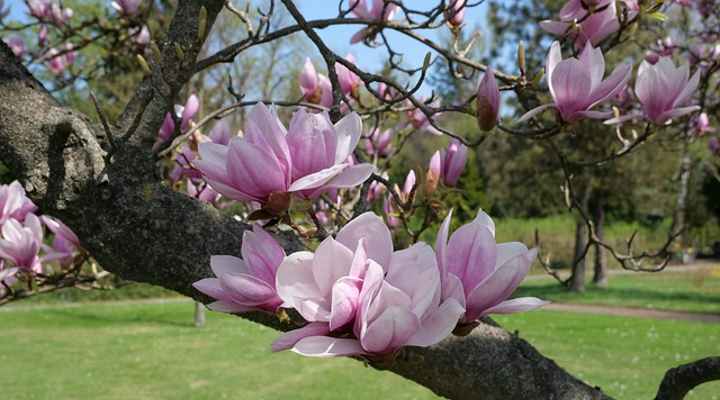
The beautiful flowers of magnolia trees and shrubs can enhance the landscaping of any garden
Magnolia is a genus of large flowering shrubs or trees in the family Magnoliaceae. Magnolia grows as a multi-stemmed shrub or a single trunk tree. The beautiful landscape tree is characterized by its fragrant flowers, glossy, leathery leaves, and cone-like fruits.
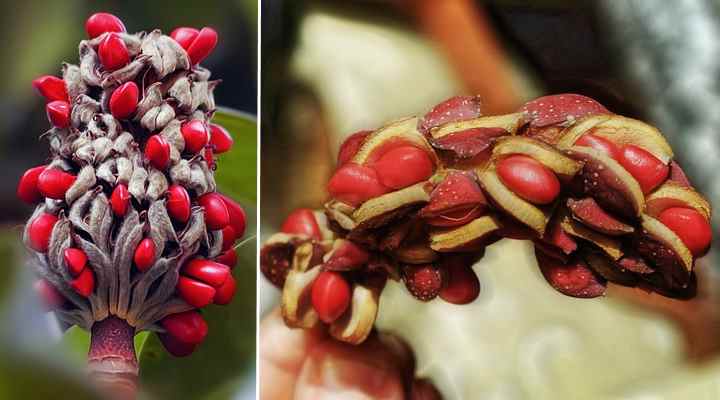
Magnolia fruit and seeds
There are some 125 species of magnolia suitable for growing in most zones. There are eight species of magnolia native to the United States. The most popular magnolia types are the Southern Magnolia (Magnolia grandiflora), Star magnolia (Magnolia stellata), and Saucer magnolia (Magnolia × soulangeana).
Most varieties of magnolia thrive in full sun or partial shade. Magnolia trees and shrubs adapt to various soil types and grow well as long as the soil is well-draining. To care for magnolia plants, water the ground to keep it moist and fertilize every spring.
Evergreen and Deciduous Magnolias
Magnolia grows well in most climates, depending on the species of tree or shrub. Evergreen magnolias are suited to growing in warm climates where winter temperatures don’t dip below freezing. Deciduous magnolia trees grow better in colder climates and will survive frost.
Here are some popular types of evergreen and deciduous magnolia trees.
Evergreen Magnolia Trees
- Southern magnolia (Magnolia grandiflora)
- White champaca (Magnolia x alba)
- Sweetbay magnolia (Magnolia virginiana)
- Scented pearl magnolia (Magnolia laevifolia)
Deciduous Magnolia Trees
- Star magnolia (Magnolia stellata)
- Saucer magnolia (Magnolia x soulangeana)
- Loebner magnolia (Magnolia × loebneri)
- Cucumber tree (Magnolia acuminata)
Some of the evergreen magnolia varieties grow in colder climates as deciduous trees.
Magnolia Flowers
One of the most distinctive features of magnolia flowers is their petal structure. Unlike many other flowering plants where the petals and sepals (the outer parts of the flower) are distinct, in magnolias, these structures are fused. This fusion results in what are known as “tepals,” a term that blends ‘petals’ and ‘sepals’ to reflect their combined form.
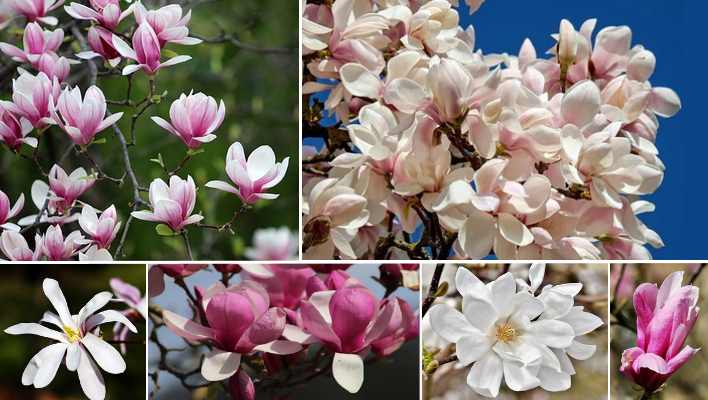
Magnolia has fragrant flowers that are most commonly white or various shades of pink color
Magnolia flowers are either star-shaped or bowl-shaped, like tulips, and can grow up to 12” (30 cm) across. The most common color of magnolia flowers is white or pink. However, magnolia trees also produce flowers that are purple, green, or even yellow. Each magnolia variety has its own distinctive bloom that helps with tree identification.
Magnolia flowers are pollinated by beetles, a relationship that dates back to ancient times. The unique structure of magnolia flowers, including their tepals (the fused petals and sepals), is thought to have evolved in part as an adaptation to beetle pollination. Beetles are attracted to the scent and reach the reproductive structures, facilitating the transfer of pollen.
Magnolia Leaves
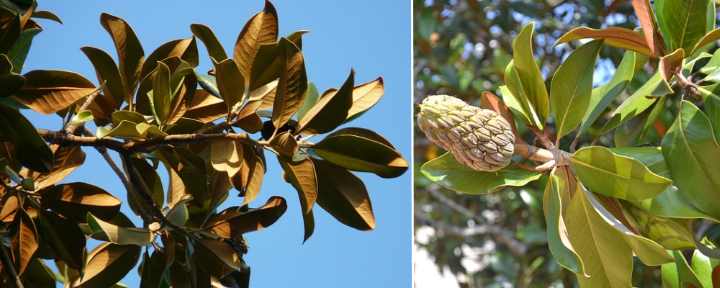
Magnolia leaves are glossy green on the upper-side and have smooth edges
Magnolia leaves are glossy, green, leathery leaves that are an ovate or lanceolate shape. The leaves on magnolia trees have a simple, alternate arrangement on woody stems. Magnolia leaves grow between 5” and 8” (12 – 20 cm) long and up to 5” (12 cm) wide. All varieties of magnolias have leaves with smooth margins.
Magnolia Tree Identification
The best way to identify magnolia trees is by their large aromatic flowers. Individual magnolia varieties have their own distinctive flowers. You can also recognize magnolia trees by their long, elongated leaves with a smooth, shiny surface. Magnolia trees are also recognized by their fruit that looks like small cones containing red seeds.
Examining the bark can help with magnolia identification. Magnolia bark is thin and smooth and contains aromatic compounds.

Bark of Southern magnolia (Magnolia grandiflora)
Types of Magnolia Trees (With Pictures) – Identification Guide
Let’s look at the identifying feature of the most popular magnolia trees.
Southern Magnolia (Magnolia grandiflora)
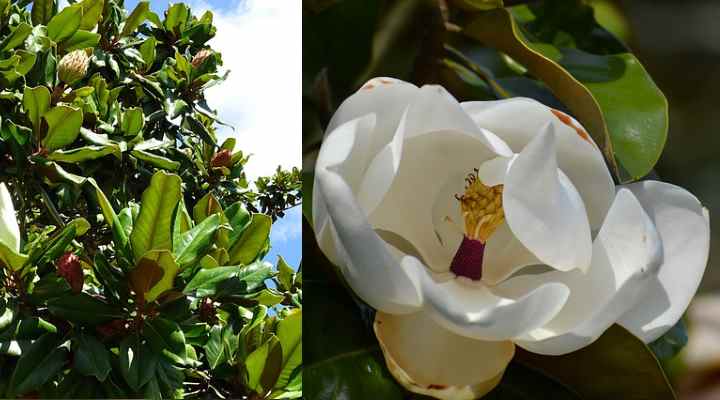
Southern magnolia (Magnolia grandiflora) leaves and white flower
Southern magnolia is a stunning ornamental tree that produces brilliant white fragrant flowers. This magnificent magnolia grows up to 80 ft. (24 m) tall with a rounded or pyramidal crown up to 50 ft. (15 m) wide. The evergreen leaves are glossy dark green, and grow up to 10” (25 cm) long.
Also known as bull bay, Southern magnolia trees are renowned for their exquisite white flowers that bloom in late spring. These magnolia flowers are state flowers in both Louisiana and Mississippi. The large white magnolia flowers are cup-shaped and are up to 12” (30 cm) across. When in bloom, Southern magnolia flowers give off a lemony aroma.
This magnolia is a fast-growing evergreen tree in USDA zones 6 through 10.
- Bloom Time: Summer months
- Plant Size: 60 to 80 ft. (18 – 24 m) tall and 30 – 50 ft. (9 – 15 m) wide
- USDA Plant Zone: 6 to 10
- Light: Full sun to partial shade
Little Gem Magnolia Tree (Magnolia grandiflora ‘Little Gem’)

‘Little Gem’ is a dwarf cultivar of Southern magnolia (Magnolia grandiflora)
Southern magnolia ‘Little Gem’ is a dwarf, evergreen tree with white cup-shaped flowers and glossy pointed green leaves. ‘Little Gem’ magnolia has a narrow, columnar growth and grows between 15 and 20 ft. (4.5 – 6 m) tall. This large shrubby magnolia bush-like tree is perfect for compact gardens.
‘Little Gem’ is a compact cultivar of the Southern magnolia. Because of this, the dwarf, bushy tree has the same characteristics as the larger species tree. The shiny evergreen foliage and white scented flowers give the ‘Little Gem’ plenty of year-long interest.
- Bloom Time: Late spring to mid-summer
- Plant Size: 15 – 20 ft. (4.5 – 6 m)
- USDA Plant Zone: 7 to 9
- Light: Full sun to partial shade
Teddy Bear Magnolia (Magnolia grandiflora ‘Southern Charm’)
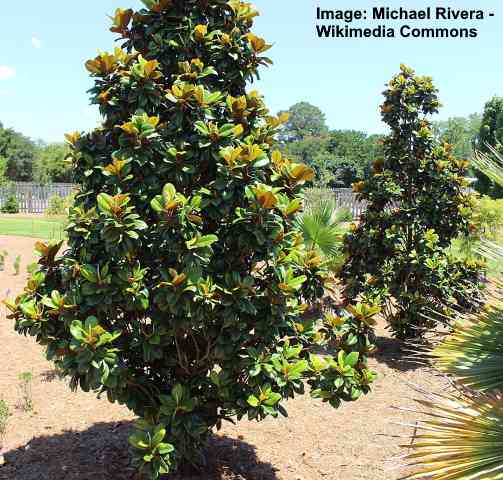
Teddy Bear magnolia (Magnolia grandiflora ‘Southern Charm’) has conical dwarf growth habit
The ‘Teddy Bear’ magnolia is a dwarf magnolia evergreen bushy shrub with a conical shape, small shiny green leathery leaves, and showy white flowers. The ‘Southern Charm’ magnolia cultivar grows around 20 ft. (6 m) high and has a moderate growth rate. Like the Southern magnolia species tree, the ‘Teddy Bear’ magnolia has brilliant white flowers in a cup shape.
The ‘Southern Charm’ magnolia bush grows best as a specimen plant. You can also plant the dwarf trees in rows as an evergreen privacy screen. This cultivar also grows well in pots or containers.
The common name “Teddy Bear” comes from the brown fuzzy underside of the lanceolate leaves.
- Bloom Time: Summer and fall
- Plant Size: 16 to 20 ft. (4.8 – 6 m) tall and 10 to 12 ft. (3 – 3.6 m) wide
- USDA Plant Zone: 7 to 9
- Light: Full sun
Star Magnolia (Magnolia stellata)
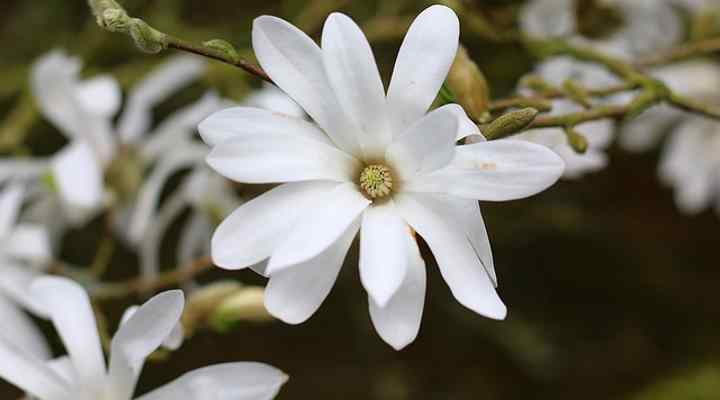
The star-shaped flowers of star magnolia (Magnolia stellata) can be white or pink, depending on the cultivar
The star magnolia is a small deciduous tree with small white, star-shaped flowers and ovate leaves. The Magnolia stellata grows up to 20 ft. (6 m) tall and has an oval crown. In the fall, when the leaves turn color, the glossy deep green leaves turn a golden yellow color.
The star magnolia is one of the first trees to bloom in spring. The individual showy flowers are made from long, delicate thin white petals. Compared to other magnolia varieties, the flowers are small, measuring only 4” (10 cm) across.
Magnolia stellata is also one of the hardiest of the magnolia bushes and grows well in zones 4 through 9.
- Bloom Time: Late winter or early spring
- Plant Size: 10 to 20 ft. (3 – 6 m) and 10 to 15 ft. (3 – 4.5 m)
- USDA Plant Zone: 4 to 9
- Light: Full Sun or partial Sun
Royal Star Magnolia (Magnolia stellata ‘Royal Star’)
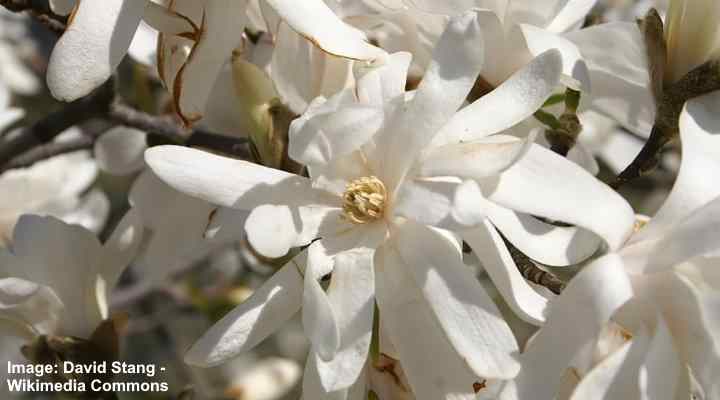
Royal Star magnolia is a small tree with star-shaped double flowers
The spectacular ‘Royal Star’ is a large magnolia bush or small tree with showy double white flowers that give off a strong fragrance. The Magnolia stellata ‘Royal Star’ dwarf, compact shrub growing between 10 and 20 ft. (3 – 6 m) tall. The hardy magnolia has glossy green, ovate leaves.
Ths ‘Royal Star’ magnolia looks stunning when it blooms in spring. The dwarf tree explodes into a mass of white, star-shaped double flowers. The flowers cover the bare branches before the leaves appear. In fall, the foliage turns yellow before the leaves drop.
Magnolia stellata ‘Royal Star’ is suitable for growing in USDA zones 4 through 8.
- Bloom Time: Early spring
- Plant Size: 10 to 20 ft. (3 – 6 m) tall with a spread of 8 – 15 ft. (2.4 – 4.5 m)
- USDA Plant Zone: 4-8
- Light: Full Sun or partial shade
Loebner Magnolia (Magnolia × loebneri)
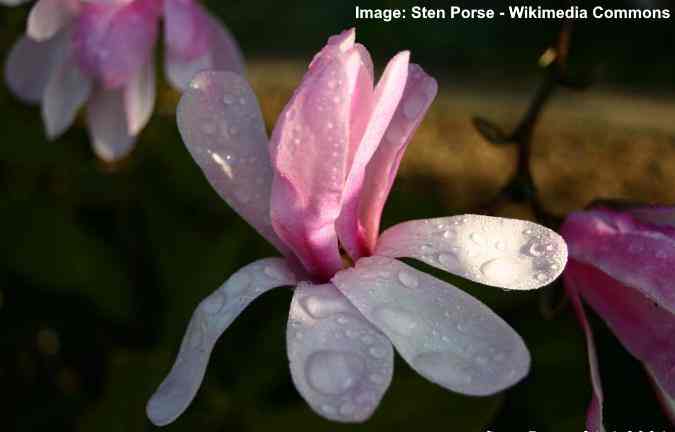
The star shaped flowers of Loebner magnolia have strap-like pink petals
The loebner magnolia is a small deciduous tree with pinkish-white flowers, narrowly elliptic leaves, and red cone-like fruits. This hardy magnolia species grows slowly and has a maximum height of 30 ft. (9 m). The multi-stemmed shrubby tree has a compact, rounded growth and grows best in shrub borders or as a specimen tree.
The outstanding feature of the Magnolia loebneri is its starry flowers. The flowers are made from long pink, lilac, or whitish-pink strap-like petals. The magnolia petals fan out from the center and are curved at the end.
- Bloom Time: Early to mid-spring
- Plant Size: 20 to 30 ft. (6 – 9 m) tall and wide
- USDA Plant Zone: 5 – 9
- Light: Full Sun or partial shade
Magnolia × loebneri ‘Leonard Messel’
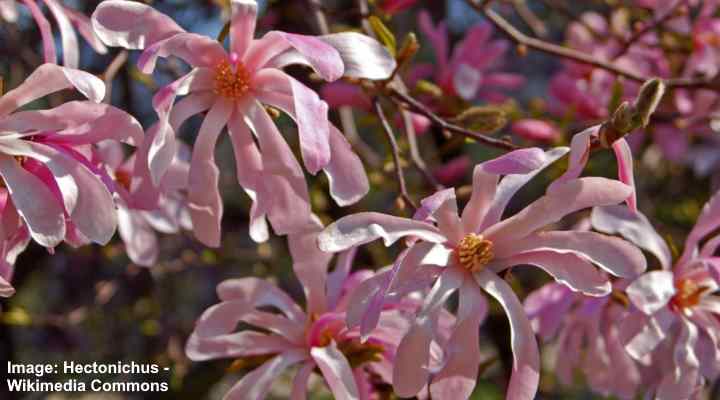
‘Leonard Messel’ magnolia has pale pink star-shaped flowers with strappy petals
The ‘Leonard Messel’ magnolia is a compact hybrid cultivar with deciduous foliage and fragrant star-like pale pink flowers. This magnolia cultivar grows between 15 and 20 ft. (4.5 – 6 m) tall. It is usually grown as a multi-stemmed tree or large shrub. ‘Leonard Messel’ cultivars are ideal for small gardens or growing as a specimen tree.
‘Leonard Messel’ magnolias are identified by their two-tone showy flowers. The narrow strappy petals are in pink and white hues. The flowers bloom in abundance throughout spring to add color and sweet scents to backyards.
- Bloom Time: Early to mid-spring
- Plant Size: 15 – 20 ft. (4 – 6 m) tall and 10 to 15 ft. (3 – 4.5 m) wide
- USDA Plant Zone: 5 to 9
- Light: Full Sun or partial shade
Sweetbay Magnolia (Magnolia virginiana)
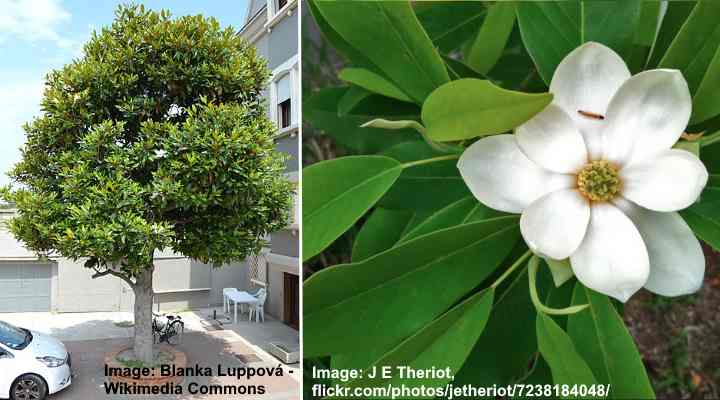
Sweetbay magnolia (Magnolia virginiana) has scented white cup-shaped flowers
The sweetbay magnolia is a native magnolia tree with cup-shaped creamy-white flowers and large glossy lanceolate or elliptical leaves. This semi-evergreen magnolia grows between 10 and 35 ft. (3 – 10 m) Depending on the climate, the magnolia has a rounded to pyramidal crown. The cup flowers are 2” to 3” (5 – 7.5 cm) across and give off a fragrant scent.
The Magnolia virginiana is also called swamp magnolia, laurel magnolia, or beaver tree.
Sweetbay magnolia grows as an evergreen tree in southern states and a deciduous magnolia bush in colder climates. The fast-growing tree is prized for its ornamental beauty, and it adds color to garden landscapes.
With the proper care, sweetbay magnolia bushes are ideal for foundation plantings, shrub borders, or growing in pots. In warmer climates, this magnolia is popular as a specimen lawn tree.
- Bloom Time: Mid-spring through summer
- Plant Size: 10 – 35 ft. (3 – 10 m) tall and wide
- USDA Plant Zone: 5 to 10
- Light: Full Sun or partial Sun
Cucumber Magnolia Tree (Magnolia acuminata)
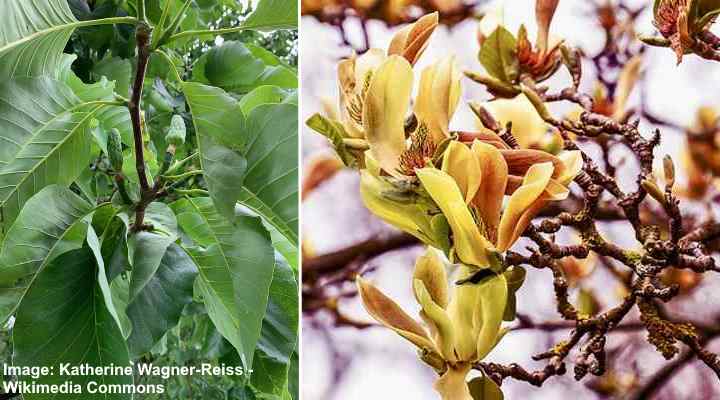
Cucumber magnolia (Magnolia acuminata) has pointed tip leaves and yellow-greenish flowers
The cucumber tree is a hardy native tree with tulip-like fragrant flowers and shiny green, ovate shaped leaves. The cucumber magnolia grows between 40 and 70 ft. (12 – 21 m) tall, and the deciduous foliage grows in a pyramidal shape. The magnolia leaves are oblong to oval shape and grow up to 10” (25 cm) long, and feature a smooth margin with pointed tip.
Unlike other magnolias, the cucumber tree doesn’t produce showy flowers. The small flowers grow in a tulip shape and are green or yellow. Due to the dense foliage, it isn’t easy to spot the flowers on this tall magnolia.
Magnolias aren’t typically recognized for outstanding fall color. However, the Magnolia acuminata is an exception as it turns an attractive golden yellow before the leaves drop.
The cucumber magnolia tree gets its common name from the cucumber-shaped fruits that appear in the fall.
Cucumber tree is hardy in zones 4 through 8, where they are common in parks and open public spaces.
- Bloom Time: Late spring to early summer
- Plant Size: 40 – 70 ft. (12 – 21 m) tall and 20 – 30 ft. (6 – 9 m)
- USDA Plant Zone: 4 to 8
- Light: Full Sun or partial shade
Jane Magnolia (Magnolia liliiflora x Magnolia stellata)

The purple flower buds of Jane magnolia open and fade to pink petals on the outside and white on the inside
The Jane magnolia is a slow-growing magnolia shrub or small tree that produces showy, cup-shaped fragrant flowers that are pink-purple and white. The large tulip flowers grow up to 8” (20 cm) across. The tree’s foliage is made up of 6-inch (15-cm) long, ovate shiny green leaves. The compact Jane magnolia bush grows between 10 and 15 ft. (3 – 4.5 m) tall.
The Jane magnolia has outstanding pink-purple tulip-like flowers. The large flowers have purple-pink colors on the outside and are white on the inside.
The Jane magnolia is part of a series of hybrids of the Magnolia liliiflora and Magnolia stellata called “The Little Girl Series.” Some of the other magnolias in the series are ‘Susan’ magnolia with purplish-red blooms and the ‘Ann’ magnolia with deep-purple, pink flowers.
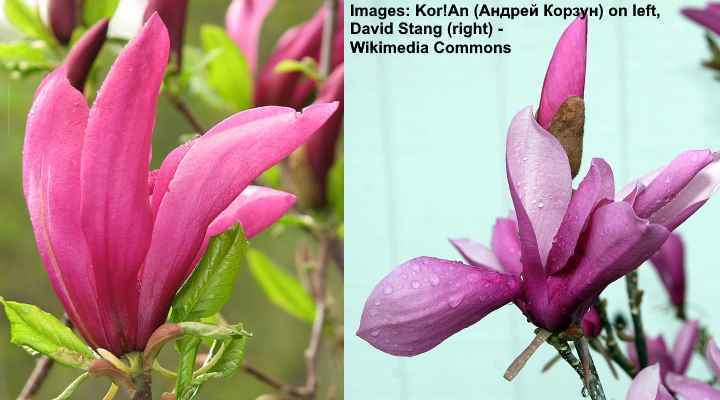
Flowers of Susan magnolia (left) and Ann Magnolia (right)
- Bloom Time: Spring
- Plant Size: 10 – 15 ft. (3 – 4.5 m) tall and 8 – 12 ft. (2.4 – 3.6 m) wide
- USDA Plant Zone: 4 to 8
- Light: Full Sun or partial Sun
Black Lily Magnolia (Magnolia liliiflora ‘Nigra’)
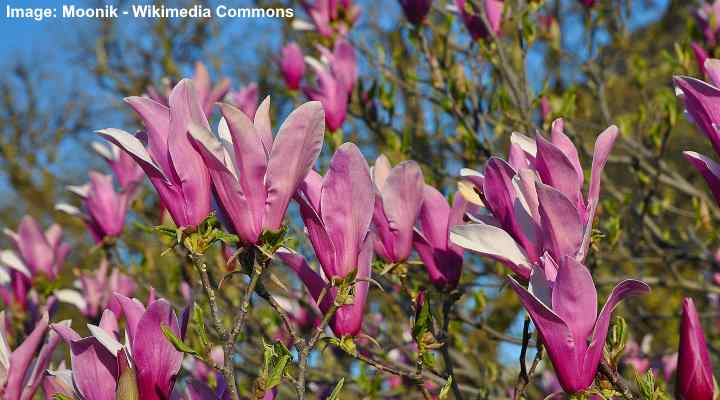
Black Lily magnolia have deep pink tulip-shaped flowers
The black lily magnolia is a large deciduous multi-stemmed shrub or small tree. The magnolia bush is identified by its rounded growth, lush, glossy green leaves, and deep pink-purple flowers. The pink showy magnolia flowers look like open tulip flowers standing erect on woody branches.
Black lily magnolia starts flowering in early spring. Under the right conditions, the shrub will flower throughout the summer, creating beautiful pink and mauve colors in your garden.
The Magnolia liliiflora ‘Nigra’ cultivar grows between 8 and 12 ft. (2.4 – 3.6 m). Grow this dwarf tree in backyards as a specimen plant for spring blooms. This magnolia thrives in USDA zones 5 through 9.
- Bloom Time: Late spring
- Plant Size: 8 to 12 ft. (2.4 – 3.6 m) tall and wide
- USDA Plant Zone: 5 to 9
- Light: Full Sun or partial shade
Magnolia ‘Butterflies’
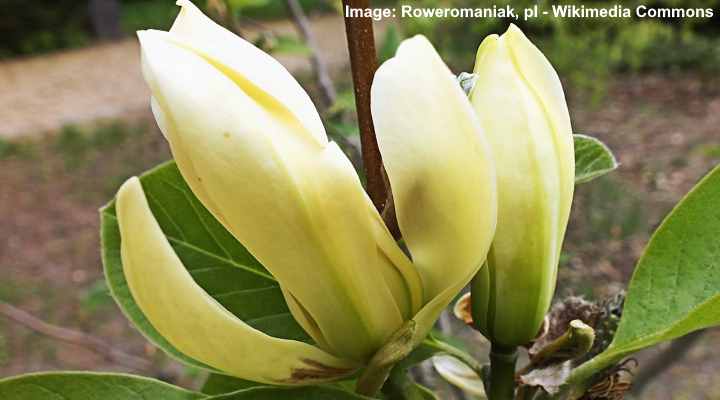
Butterflies magnolia has attractive yellow cup-shaped flowers
Butterflies magnolia is a deciduous compact hybrid plant producing yellow cup-shaped flowers and oblong-elliptic dark green leaves with pointed tips. The showy canary-yellow magnolia flowers give off a distinct lemon scent. The magnolia tree looks like a yellow mass of showy blooms due to the massive number of flowers when in bloom.
Magnolia ‘Butterflies’ is a cross between the cucumber magnolia (Magnolia acuminata) and Yulan magnolia (Magnolia denudata). The magnolia tree has pyramidal growth and grows between 15 and 20 ft. (4.5 – 6 m). Like most deciduous magnolias, the yellow butterfly magnolia tree thrives in zones 5 through 9.
Many people regard the magnolia ‘Butterflies’ as the finest example of a yellow-flowering tree.
- Bloom Time: Mid-spring
- Plant Size: 15 – 20 ft. (4.5 – 6 m) tall and 10 – 15 ft. wide (3 – 4.5 m)
- USDA Plant Zone: 5 to 9
- Light: Full Sun or partial shade
Saucer Magnolia (Magnolia x soulangeana)

Saucer magnolia or Japanese magnolia has large flowers that come in shades of pink, purple and white
The saucer magnolia or Japanese magnolia is one of the most popular deciduous flowering trees. The saucer magnolia (Magnolia soulangeana) produces stunning purple, white, and pink flowers. As the buds open, the flowers grow into fragrant globular blooms that are usually two-toned. In fall, the glossy green leaves turn golden brown before dropping. This magnolia species is prized for its huge bicolored flowers.
Saucer magnolia is a large shrub or small tree that grows between 15 and 25 ft. (4.5 – 7 m) tall and has a rounded, spreading crown.
Saucer magnolias are also called the Chinese magnolia and tulip magnolia.
From all the deciduous magnolias, the saucer magnolia is one of the easiest to grow. Cultivars of saucer magnolias are resistant to wind and alkaline soils. Grow these magnolia plants as a specimen tree or multi-trunked large shrub.
Some outstanding Magnolia soulangeana cultivars are ‘Grace McDade’ with huge cup-shaped flowers 14” (35 cm) in diameter and ‘Jurmag1’ with dark magnolia flowers.
The Magnolia soulangeana ‘Lilliputian’ is the smallest of the saucer magnolias suitable for compact gardens.
The Magnolia soulangeana ‘Alexandrina’ cultivar is a multi-stemmed deciduous tree with large fragrant cup-shaped deep pink flowers and can reach to about 30 feet tall (9 m).
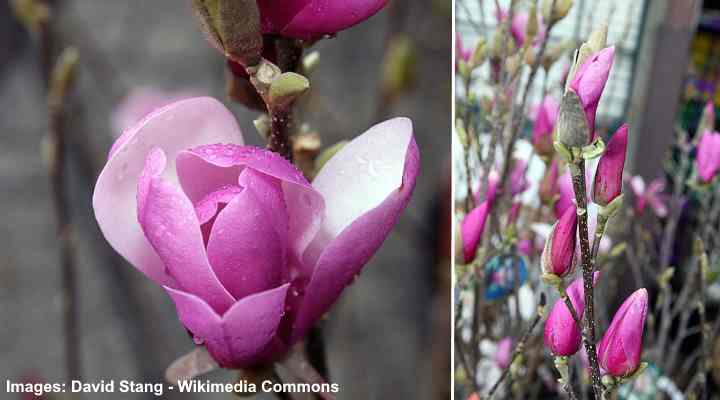
Flowers of magnolia soulangeana ‘Alexandrina’
- Bloom Time: Early to mid-spring through fall
- Plant Size: 15 – 25 ft. (4.5 – 7.6 m) tall and 20 – 25 ft. (6 – 7.6 m) spread
- USDA Plant Zone: 5 to 9
- Light: Full Sun or partial shade
Magnolia ‘Black Tulip’ (Magnolia x soulangeana ‘Black Tulip’)
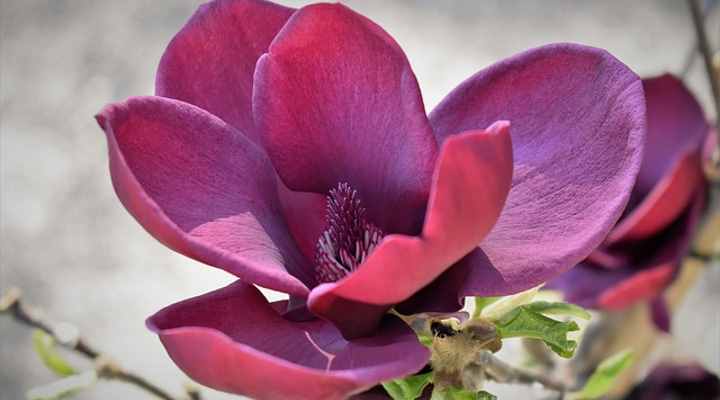
‘Black Tulip’ magnolia has cup-shaped dark flowers that come in shades of deep purple-burgundy
The ‘Black Tulip’ saucer magnolia cultivar has some of the darkest flowers on any magnolia species. The goblet-shaped magnolia flowers are in dark purple or deep burgundy colors. The large magnolia tulip-like flowers grow up to 6” (15 cm) across. The magnolia leaves are obovate-shaped and are up to 8” (20 cm) long.
Under the right conditions, ‘Black Tulip’ magnolias bloom from spring until summer. If the summer is cool and damp, the trees may burst into bloom again in mid-summer.
‘Black Tulip’ magnolias are large shrubs or trees that grow between 15 and 20 ft. (4.5 – 6m). This magnolia species features upright growth and a rounded crown with a spread up to 10 ft. (3 m) wide.
You can grow ‘Black Tulip’ magnolias as a single trunk specimen tree or prune them to form a flowering hedge plant.
- Bloom Time: Early spring
- Plant Size: Height 15 – 20 ft. (4.5 – 6 m) tall and 6 – 10 ft. (1.8 – 3 m)
- USDA Plant Zone: 5 to 9
- Light: Full Sun or partial shade
Magnolia Betty (Magnolia liliiflora ‘Nigra’ x Magnolia stellata ‘Rosea’)
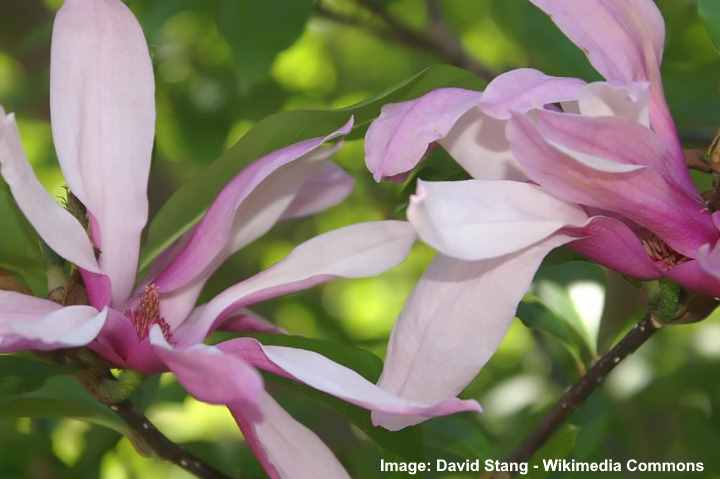
‘Betty’ magnolia has pink-purple flowers with white interiors
The ‘Betty’ magnolia is a small deciduous magnolia shrub ideal for small, compact backyards. The shrubby magnolia is a late spring bloomer that produces large pink-purple flowers. Inside the cup-shaped flowers, the petals are white, which contrasts with the dark exteriors. Magnolia ‘Betty’ grows between 10 and 15 ft. (3 – 4.5 m) and is hardy in USDA zones 4 through 8.
- Bloom Time: April to May
- Plant Size: Height: 10 – 15 ft. (3 – 4.5 m), Spread: 10 – 15 ft. (3 – 4.5 m)
- USDA Plant Zone: 4 to 8
- Light: Full Sun, Partial Sun
Magnolia champaca
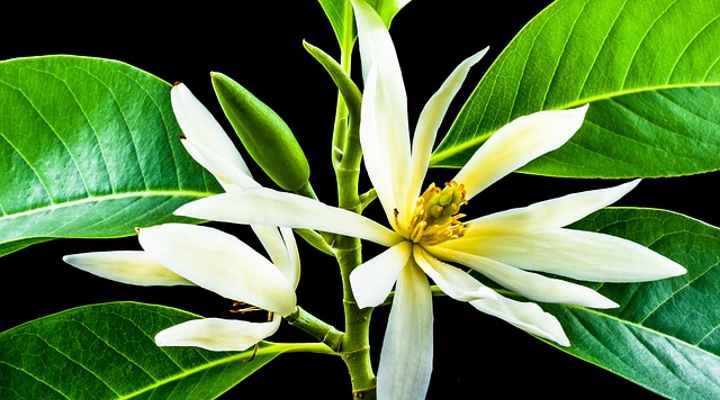
Magnolia champaca has fragrant creamy-yellow flowers
The Magnolia champaca is a tall tree with intensely fragrant yellow or cream-colored flowers and long, lanceolate leaves with smooth edges. This magnolia species grows up to 50 ft. (15 m) tall with a narrow crown. Common names for Magnolia champaca include the yellow jade orchid tree, joy perfume tree, and Himalayan champaca. The champaca magnolia tree blooms in summer and early fall.
- Bloom Time: Spring
- Plant Size: Height 50 ft. (15 m), Spread 16.4 ft. (5 m)
- USDA Plant Zone: 10, 11
- Light: Full Sun, Partial Shade
Ashe Magnolia (Magnolia macrophylla var. ashei)
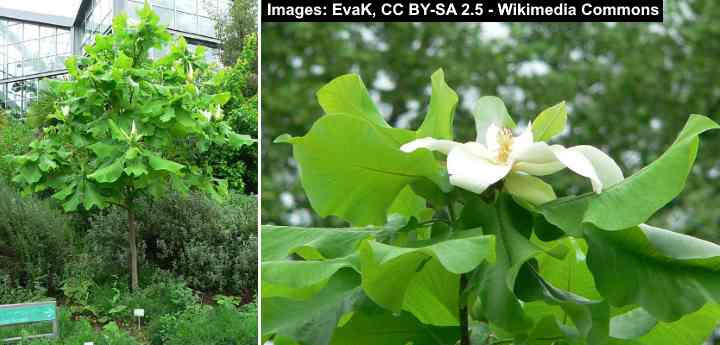
The white flowering Ashe magnolia has distinctive leaves and is small enough to suit tight spaces
Ashe magnolia is a large white-flowering shrub or small deciduous tree, famed for its large, fragrant flowers and unique foliage. Blooming in spring and summer, ashei magnolia white flowers are showy cup-shaped blooms measuring 10” (25 cm) across. It has large, oblong-obovate leaves 3 ft. (1 m) long and 1 ft. (0.3 m) wide.
Ashe magnolias are native to the southeastern United States. The large-leafed shrub-like tree thrives in river valleys and ravines. However, it’s mostly grown as a flowering shade tree or specimen tree in residential landscapes.
- Bloom Time: Early spring and late summer
- Plant Size: 30 to 40 ft. (9 to 12 m) tall and wide
- USDA Plant Zone: 5 to 8
- Light: Full sun to partial shade
Southern Magnolia ‘Brittany’ (Magnolia grandiflora ‘Brittany’)
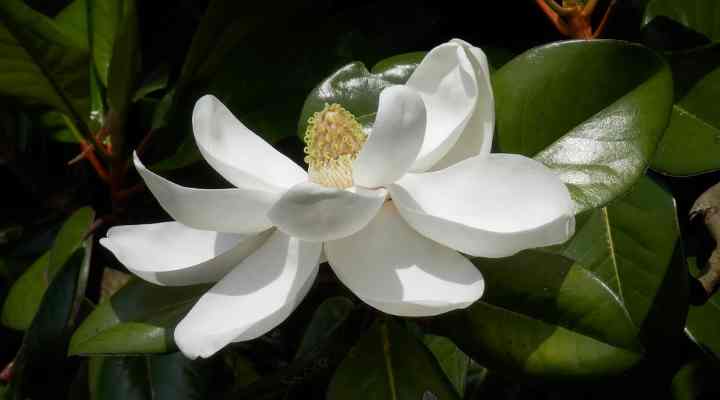
Southern Magnolia ‘Brittany’ (Magnolia grandiflora ‘Brittany’)
Southern magnolia ‘Brittany’ is a small shrub with white summer flowers and glossy green leathery leaves. The identifying feature of the ornamental shrub is its brilliant white, cup-shaped flowers with spoon-like petals. Ideal for yards with limited space, the southern dwarf magnolia doesn’t grow taller than 20 ft. (6 m).
The ‘Brittany’ cultivar is known for its large creamy-white flowers 8” to 10” (20 – 25 cm) wide. Its compact growth, fragrant white flowers, and evergreen foliage make it ideal for foundation planting, a small patio tree, or a privacy screen. It also performs well in containers in small yards.
- Bloom Time: Summer
- Plant Size: 15 to 20 ft. (4.5 – 6 m) tall and up to 10 ft. (3 m) wide
- USDA Plant Zone: 6 to 9
- Light: Full sun, dappled sunlight, or partial shade
Southern Magnolia ‘Bracken’s Brown Beauty’ (Magnolia grandiflora ‘Bracken’s Brown Beauty’)
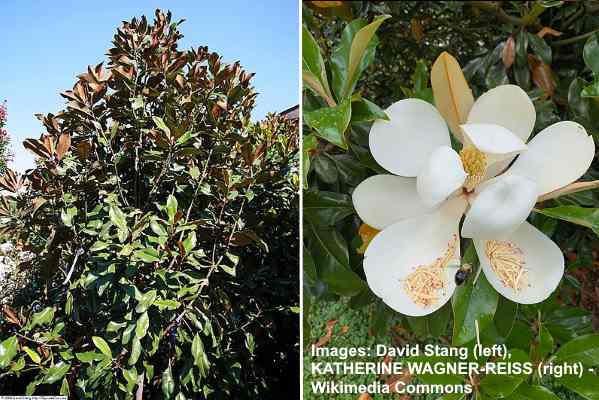
Southern magnolia ‘Bracken’s Brown Beauty’ is a hardy cultivar that can tolerate light frosts
The southern magnolia ‘Bracken’s Brown Beauty’ is a stunning evergreen tree with fragrant white flowers that bloom in spring. Thriving in full sun, this magnolia cultivar is known for its large creamy-white flowers 6” (15 cm) across and glossy green leaves with cinnamon undersides. It doesn’t grow more than 50 ft. (15 m) tall.
‘Bracken’s Brown Beauty’ is cold-hardy and an excellent landscaping plant for temperate climates. When young, the beautiful tree has a pyramidal shape but matures to a rounded form. You can plant the evergreen tree as a specimen tree, shade tree, windbreak, or hedge plant.
- Bloom Time: Late spring and early summer
- Plant Size: 30 to 50 ft. (9 – 15 m) tall and 15 to 30 ft. (4.5 – 9 m) wide
- USDA Plant Zone: 5 to 9
- Light: Full sun
Magnolia Dwarf Hybrid ‘Genie’ (Magnolia soulangeana x liliiflora ‘Genie’)
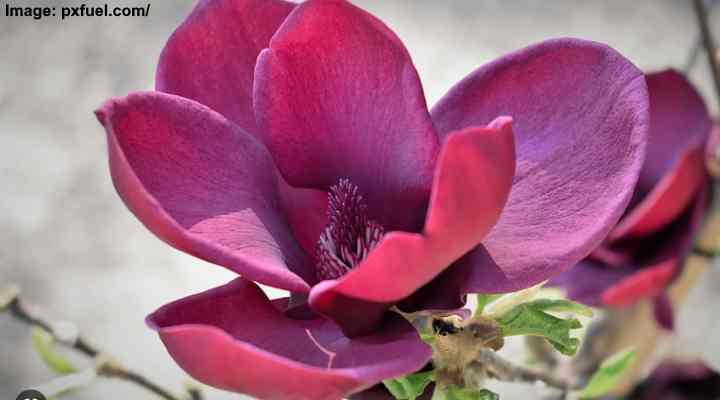
Magnolia dwarf hybrid ‘Genie’ is a small deciduous tree with stunning deep pink flowers
The magnolia dwarf hybrid ‘Genie’ is a stunning dark pink to red-flowering deciduous tree that produces scented spring blossoms. This small magnolia hybrid has maroon-purple tulip-like blossoms blooming from conical fuzzy flower buds. Its green leaves are elliptical and turn golden yellow in the fall. This dwarf magnolia doesn’t grow taller than 13 ft. (4 m).
The magnolia ‘Genie’ plant is ideal for growing in smaller gardens or limited spaces. The large, deep purple-red flowers add rich colors to landscapes in early spring. Also, its eye-catching glossy dark green leaves add lush textures and colors to summer gardens. This low-maintenance tree adapts well to a variety of well-drained soil types.
- Bloom Time: Late spring and early summer
- Plant Size: 10 to 13 ft. (3 – 4 m) tall and 5 to 6 ft. (1.5 – 1.8 m) wide
- USDA Plant Zone: 5 to 9
- Light: Full sun
Merrill Magnolia (Magnolia x loebneri ‘Merrill’)
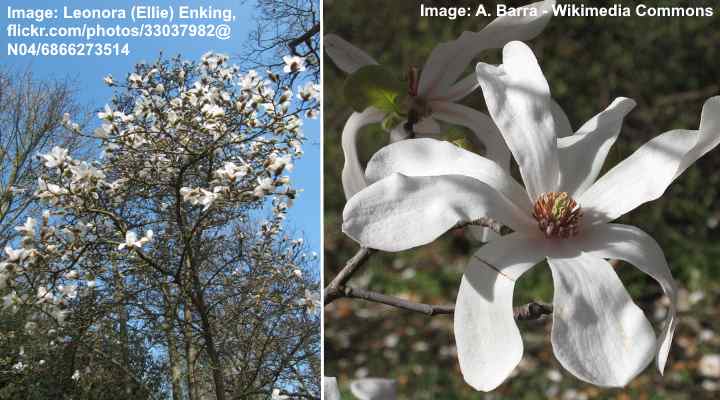
Merrill magnolia has attractive fragrant white flowers
The Merrill magnolia is a small ornamental tree with large white star-shaped flowers blooming in late-spring. The fragrant white blossoms appear on bare branches and cover the tree before the luscious green leaves appear. The highly fragrant white magnolia starburst flowers measure 3” to 4” (7.5 – 10 cm).
Merril magnolia grows up to 60 ft. (18 m) tall and withstands cold temperatures and some frost. Thriving in full sun and organically rich, well-drained soil, the decorative tree is ideal as a specimen plant, understory tree, lawn plant, or trimmed to grow as a foundation planting.
- Bloom Time: Late spring and early summer
- Plant Size: 20 to 60 ft. (6 – 18 m) tall and 20 to 45 ft. (6 – 14 m) wide
- USDA Plant Zone: 5 to 9
- Light: Full sun
Umbrella Magnolia (Magnolia tripetala)
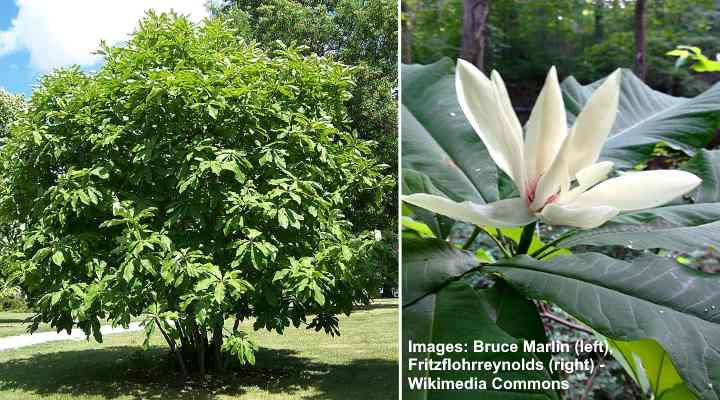
Umbrella magnolia thrives in both sun and shade and its white flowers emit an unpleasant smell
The umbrella magnolia is a deciduous white-flowering tree with bowl-shaped blossoms consisting of spindly petals. Thriving in full sun to deep shade, the multi-trunked deciduous tree is identified by its creamy white odorous flowers, leaves growing like an umbrella’s spokes, cone-shaped red fruits, and thin gray bark.
Also called the umbrella tree, this magnolia tree is native to the southeastern United States. It grows up to 30 ft. (9 m) tall and wide. It’s also one of the few magnolia trees that tolerates full shade. This low-maintenance tree is ideal as a specimen tree, planted in groupings, or as a focal point in a lawn.
- Bloom Time: Mid-spring through summer
- Plant Size: 15 to 30 ft. (4.5 – 9 m) tall and wide
- USDA Plant Zone: 5 to 9
- Light: Full sun, partial shade, full shade
Sweetbay Magnolia ‘Green Shadow’ (Magnolia virginiana ‘Green Shadow’)

Sweetbay Magnolia ‘Green Shadow’ (Magnolia virginiana ‘Green Shadow’)
Sweetbay magnolia’ Green Shadow’ is a small to medium-sized evergreen tree known for its attractive fragrant flowers that bloom in May and June. The beautiful small, white, lemon-scented flowers contrast nicely with glossy, dark green leaves. The flowers measure 2” (5 cm) in diameter, and the leaves are 5” (13 cm) long.
Sweetbay magnolia’ Green Shadow’ is a versatile landscaping tree with a long blooming period. Its attractive leaves have silvery undersides that shimmer in summer breezes. The tree is evergreen in warmer zones but semi-evergreen in colder zones. Due to its dense foliage, you can plant this ornamental magnolia as a specimen tree, hedge, or privacy screen.
- Bloom Time: Early to mid-summer
- Plant Size: 35 ft. (10 m) tall and 18 ft. (5.5 m) wide
- USDA Plant Zone: 5 to 10
- Light: Full sun or partial shade
Southern Magnolia ‘Kay Parris’ (Magnolia grandiflora ‘Kay Parris’)
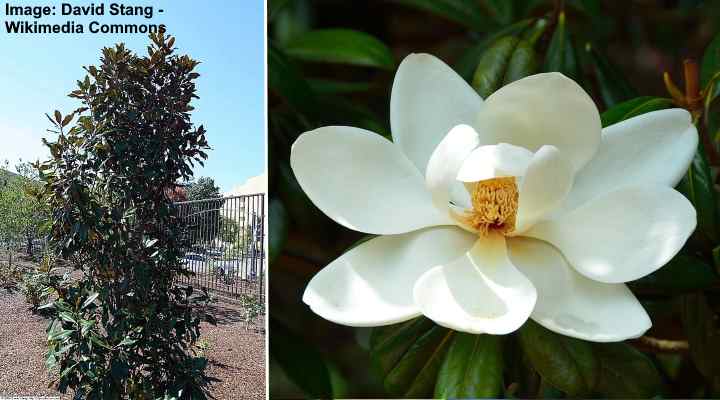
Southern magnolia ‘Kay Parris’ is a small ornamental evergreen tree with fragrant white flowers
Southern magnolia ‘Kay Parris’ is a compact flowering tree with fragrant creamy-white bowl-shaped flowers and leathery leaves. This fast-growing magnolia thrives in full sun. Its identifying features are showy white flowers 10” (25 cm) across, large oblong leaves with wavy margins and orange-brown undersides, and cone-shaped seed pods containing rose-red seeds.
The ‘Kay Parris’ southern magnolia cultivar is perfect for small yards due to its compact, pyramidal shape. Its dense evergreen foliage and lemon-scented white flowers make it a great tree for a tall hedge, shade tree, or privacy screening. Its fragrant flowers attract pollinators like bees and butterflies.
- Bloom Time: Late spring and through summer until fall
- Plant Size: 15 to 20 ft. (4.5 – 6 m) tall and 8 to 10 ft. (2.4 – 3 m) wide
- USDA Plant Zone: 7 to 9
- Light: Full sun or partial shade
Anise Magnolia (Magnolia salicifolia)
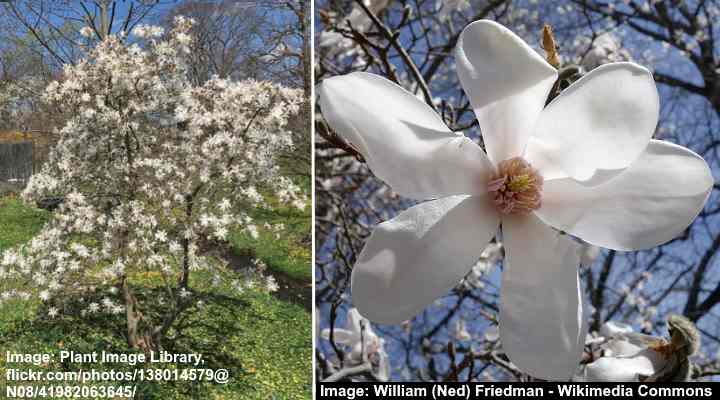
Anise magnolia is a deciduous tree that can be identified by its narrow leaves and unique fragrance
Also called willow-leaf magnolia, this stunning ornamental tree is famed for its cup-shaped white flowers that emit an anise scent. Blooming in early spring, the white flowers with six to nine petals appear on bare branches. The fragrant flowers measure 4” (10 cm) wide, and the tree’s willow-like leaves create a dense canopy.
Anise magnolia star-shaped flowers and glossy green foliage have tremendous ornamental appeal. Thriving in full sun and well-drained soil, the low-maintenance tree has a rounded canopy, making for an eye-catching focal point in a backyard. Anise magnolia also has golden yellow fall foliage, adding to its beauty.
- Bloom Time: Late spring until fall
- Plant Size: 20 to 50 ft. (6 – 15 m) tall and wide
- USDA Plant Zone: 6 to 9
- Light: Full sun or partial shade
Banana Magnolia (Magnolia figo)
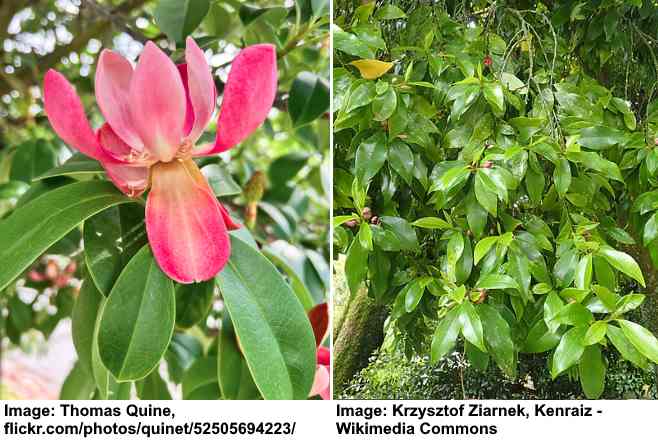
Banana magnolia is a multi-stemmed shrub with white or purple-pink flowers, depending on the cultivar
The banana magnolia is a fragrant white or pink-purple flowering shrub that blooms in spring with ivory flowers that smell like bananas. Banana magnolia is a slow-growing evergreen plant with 4” (10 cm) long obovate leaves, creating a dense, mounding form. The attractive foliage contrasts nicely with the purple-pink or creamy-white flowers.
Banana magnolia thrives in warmer climates in full sun and well-drained soil—it can tolerate drought, heat, and direct sunlight. This compact shrub is an ideal specimen plant for growing as an evergreen hedge, foundation planting, or border shrub.
- Bloom Time: Early to mid-spring
- Plant Size: 6 to 15 ft. (1.8 – 4.5 m) tall and 6 to 8 ft. (1.8 to 2.4 m) wide
- USDA Plant Zone: 7 to 10
- Light: Full sun to partial shade
Magnolia ‘Ann’
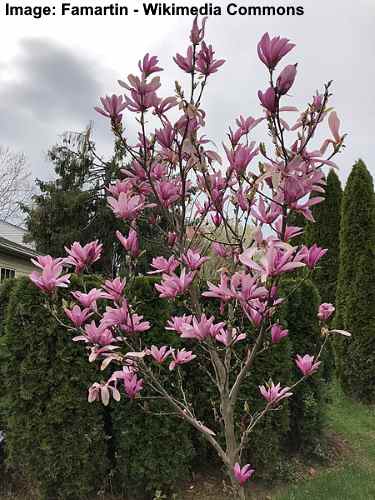
Magnolia ‘Ann’
Magnolia ‘Ann’ is a beautiful purple-flowering shrub or small tree that blooms in spring with fragrant pink-purple flowers. Thriving in full sun, this ornamental shrub is slow-growing. It produces large, medium green, ovate leaves that turn golden yellow in the fall. Its fragrant flowers measure 4” (10 cm) in diameter.
This compact dwarf magnolia shrub is great for smaller gardens or landscapes. It is also popular for planting near patios or walkways to enjoy its fragrant blooms and shade. This cold-hardy magnolia performs well as a small specimen tree or ornamental shrub in small gardens.
- Bloom Time: Mid to late spring
- Plant Size: 8 to 10 ft. (2.4 – 3 m) tall and wide
- USDA Plant Zone: 3 to 8
- Light: Full sun or partial shade
Bigleaf Magnolia (Magnolia macrophylla)
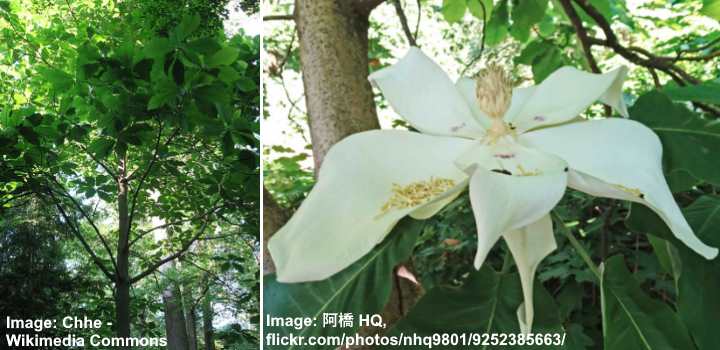
Bigleaf Magnolia (Magnolia macrophylla)
Bigleaf magnolia is a deciduous white-flowering tree known for its large, showy flowers and huge tropical leaves. The fragrant white flowers are 8” to 10” (20 – 25 cm) across, and its large obovate leaves are 36” (90 cm) long and 12” (30 cm) wide. It grows up to 40 ft. (12 m) tall.
Bigleaf magnolia thrives in full sun or partial shade in organically rich, moist, well-drained soils. The low-maintenance, drought-tolerant beautiful tree performs well as a specimen or shade tree in medium to large-sized landscapes. Like all magnolia varieties, it has egg-shaped fruits containing red seeds.
- Bloom Time: Late spring to early fall
- Plant Size: 30 to 40 ft. (9 – 12 m) tall and wide
- USDA Plant Zone: 6 to 9
- Light: Full sun to partial shade
Magnolia ‘Felix’
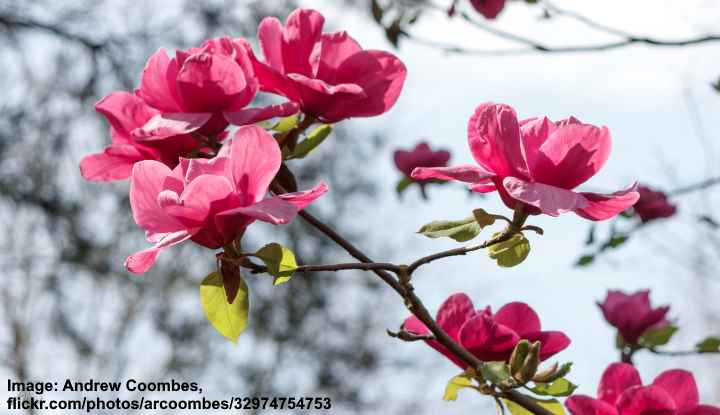
Magnolia ‘Felix’
Magnolia’ Felix’ is a stunning tree known for its large, showy dark pink or rosy-red flowers and large green leaves. This sun-loving ‘Felix’ magnolia blooms in late spring for several weeks. The eye-catching flowers are 12” (30 cm) in diameter, and its leaves are 10” (25 cm) long. The fragrant blooms attract pollinators like bees and butterflies.
‘Magnolia ‘Felix’ grows up to 16 ft. (5 m) tall, and its attractive upright, pyramidal shape looks spectacular when vibrant red flowers cover bare branches. This cold-tolerant flowering tree is a great addition to compact garden landscapes as a specimen tree or to create a focal point.
- Bloom Time: Late spring to early mid-summer
- Plant Size: 10 to 16 ft. (3 – 5 m) tall and up to 11 ft. (3.5 m) wide
- USDA Plant Zone: 5 to 9
- Light: Full sun, dappled sunlight, or partial shade
Magnolia ‘Galaxy’
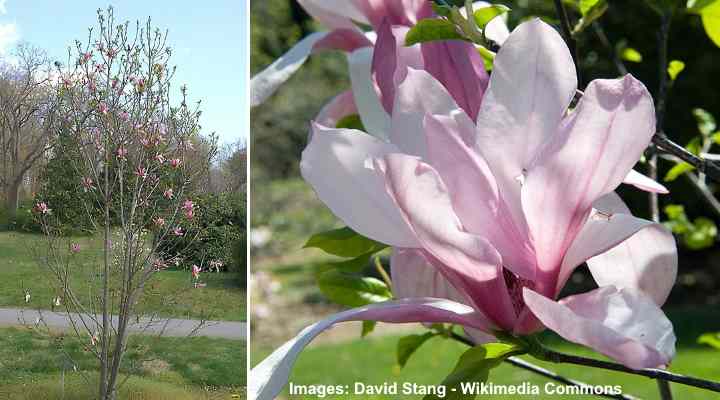
Magnolia ‘Galaxy’
Magnolia’ Galaxy’ is a stunning deciduous tree that produces red-purple buds that bloom dark pink flowers in spring. Thriving in full sun, the unique magnolia tree has tulip-like pinkish, 12-petalled flowers 8” (20 cm) across. The fragrant pink flowers contrast nicely with the dark green, oval leaves.
This hybrid magnolia grows up to 40 feet (12 m) tall and 25 ft. (7 m) wide and features a narrow, pyramidal habit. The long-lasting spring flowers add a pop of vibrant colors to landscapes. Because the magnolia flowers bloom late in spring, they usually escape late frost damage. It is a low-maintenance tree that requires minimal pruning.
- Bloom Time: Late spring through summer
- Plant Size: 30 to 40 ft. (9 – 12 m) tall and 10 to 25 ft. (6 – 7 m) wide
- USDA Plant Zone: 5 to 9
- Light: Full sun, partial sun, or partial shade
Oyama Magnolia (Magnolia sieboldii)
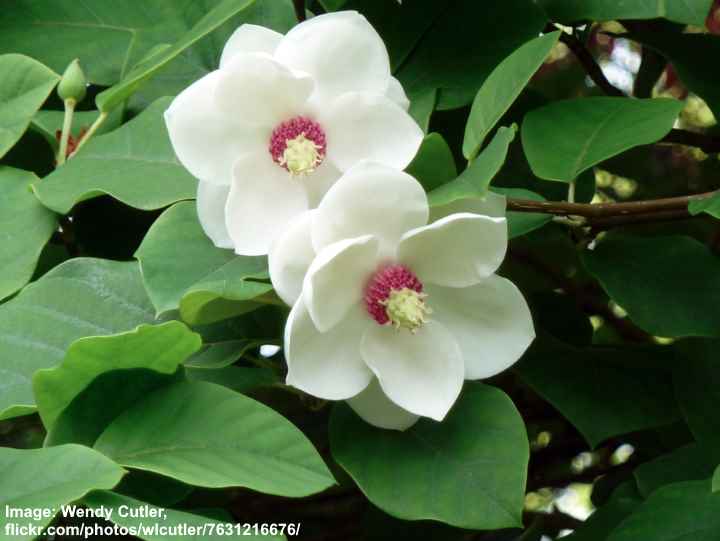
Oyama Magnolia (Magnolia sieboldii)
The Oyama magnolia blooms in late spring with stunning cup-shaped, fragrant, creamy-white flowers. The white flowers bloom from nodding egg-shaped buds. The attractive rounded white petals contrast with bright crimson stamens and mature into showy pink fruits. The large shrub’s elliptic leaves are 3” to 6” (7.5 – 15 cm) long and turn yellow in the fall.
Oyama magnolias are attractive ornamental shrubs or small trees. The plant’s vase shape creates an eye-catching focal point in summer gardens. It’s also compact enough to plant in containers or beside patios in small gardens. Its colorful pink buds, white flowers, and green foliage add color and texture to garden landscapes.
- Bloom Time: Late spring through summer until fall
- Plant Size: 10 – 15 ft. (3 – 4 m) tall wide
- USDA Plant Zone: 6 – 9
- Light: Full sun to partial shade
Kobus Magnolia (Magnolia kobus)

Kobus Magnolia (Magnolia kobus)
Magnolia Kobus is a sun-loving deciduous tree known for its beautiful, fragrant white flowers. The early-blooming decorative tree has goblet-shaped white flowers 4” (10 cm) in diameter, oblong-obovate leaves 8” (20 cm) long, and a spreading, conical habit. The tree has dark green, ovate leaves that turn yellow in the fall.
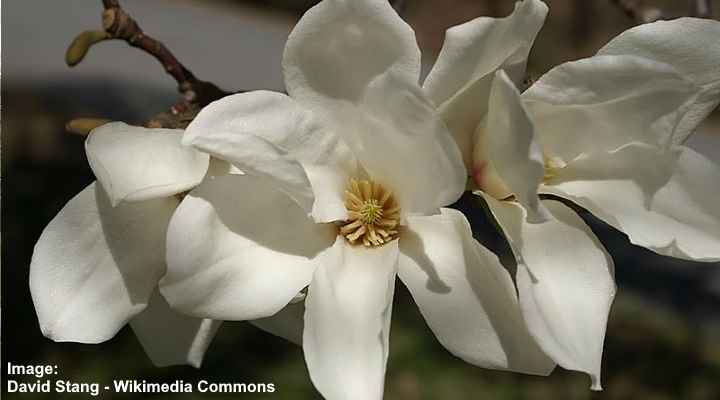
Kobus magnolia flowers
The small to medium-sized kobus magnolia tree grows up to 50 ft. (15 m) tall. Its conical shape, silky gray flower buds, white flowers on bare branches, red seed pods 3” (7.5 cm) long, and lush green leaves give the tree plenty of visual appeal. The tall magnolia is an ideal shade tree, specimen tree, or focal point in a large residential yard.
- Bloom Time: Early spring to early summer
- Plant Size: 25 – 50 ft. (7 – 15 m) tall wide
- USDA Plant Zone: 5 – 8
- Light: Full sun to partial shade
Sargent’s Magnolia (Magnolia sargentiana)
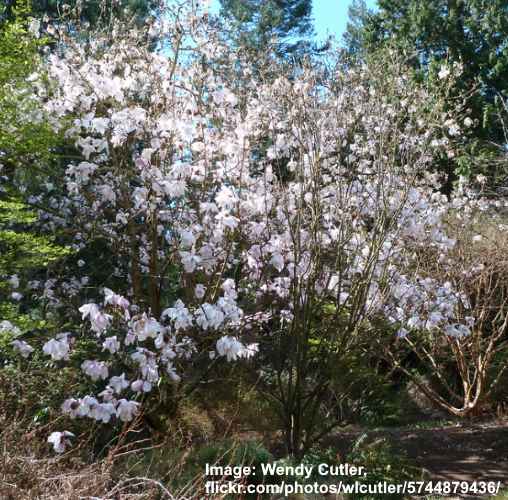
Sargent’s Magnolia (Magnolia sargentiana)
Sargent’s magnolia is a stunning flowering deciduous shrub or small tree with abundant large, fragrant, white, or pink flowers. Blooming in early spring and full sun, the bowl-shaped pale-pink flowers are pure white on the inside. The large flowers, 12” (30 cm) wide, contrast nicely with the 8” (20 cm) long leaves.
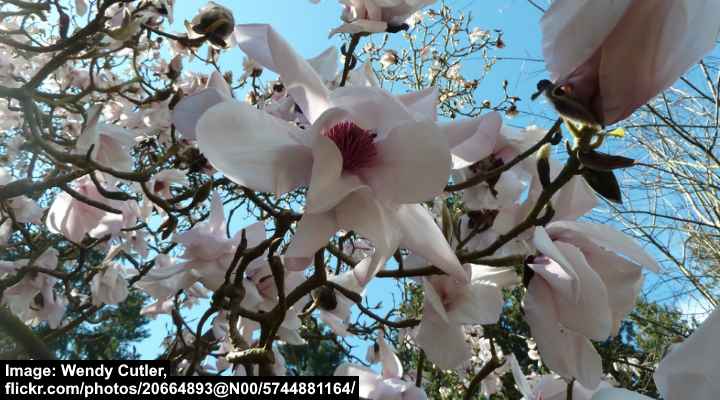
Sargent’s magnolia flowers
Sargent’s magnolia grows up to 35 ft. (11 m) tall and wide. The ornamental shrub has a rounded shape, creating an eye-catching focal point in small to medium-sized garden landscapes. Additionally, the cone-red fruits add interest to the tree late in the season. They also attract birds and other wildlife to the garden.
- Bloom Time: Early spring
- Plant Size: 30 – 35 ft. (9 – 11 m) tall wide
- USDA Plant Zone: 7 – 9
- Light: Full sun to partial shade
Magnolia x brooklynensis ‘Yellow Bird’
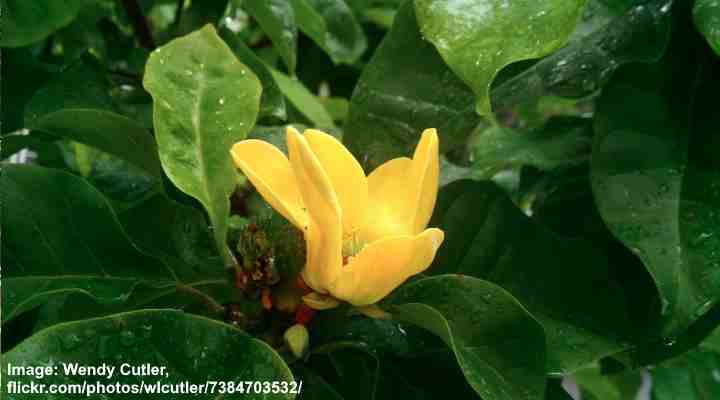
Magnolia x brooklynensis ‘Yellow Bird’
The ‘Yellow Bird’ magnolia hybrid is a small to medium-sized tree with bright tulip-like yellow flowers blooming in mid-May. Identifying features of the yellow-flowering tree are its conical habit, glossy green elliptical leaves with pointed tips, and cup-shaped yellow blooms. The delightful flowers measure 4” (10 cm) wide and 9” (23 cm) long.
The magnolia hybrid ‘Yellow Bird’ is a stunning addition to small garden landscapes. Growing up to 40 ft. (12 m) tall and 25 ft. (7.6 m) wide, the ornamental tree is ideal for shade. Its yellow flowers and shiny foliage give gardens plenty of color and fragrance from spring through fall.
- Bloom Time: Early spring for three weeks
- Plant Size: 20 – 40 ft. (6 – 12 m) tall and 15 to 25 ft. (4.5 – 7.6 m) wide
- USDA Plant Zone: 5 – 9
- Light: Full sun to partial shade
Yulan Magnolia (Magnolia denudata)
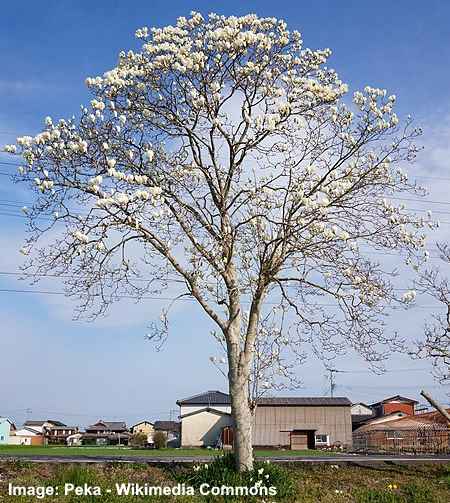
Yulan Magnolia (Magnolia denudata)
The Yulan magnolia is one of the most beautiful magnolia trees due to its masses of creamy to ivory-white tulip-shaped flowers. Also known as the lily tree, the Yulan magnolia features upward-facing white flowers 3” (7.5 cm) in diameter that bloom in late winter or early spring. The hardy white blooms may get damaged by late frosts.
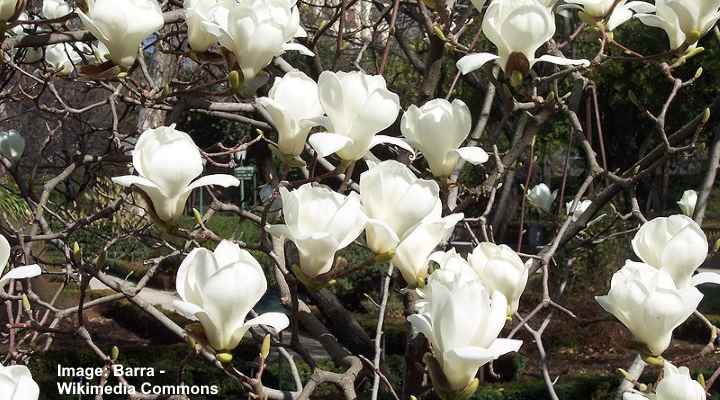
Yulan magnolia flowers
The Yulan magnolia grows up to 40 ft. (12 m) tall and wide. This stunning white-flowering magnolia has a rounded, broad-spreading crown of deciduous, ovate leaves appearing in mid-spring. You can plant the ornamental magnolia tree as a decorative landscaping tree in full sun to add beauty to a landscape.
- Bloom Time: Late winter and early spring
- Plant Size: 30 – 40 ft. (9 – 12 m) tall and wide
- USDA Plant Zone: 5 – 8
- Light: Full sun to partial shade
Magnolia ‘Daybreak’
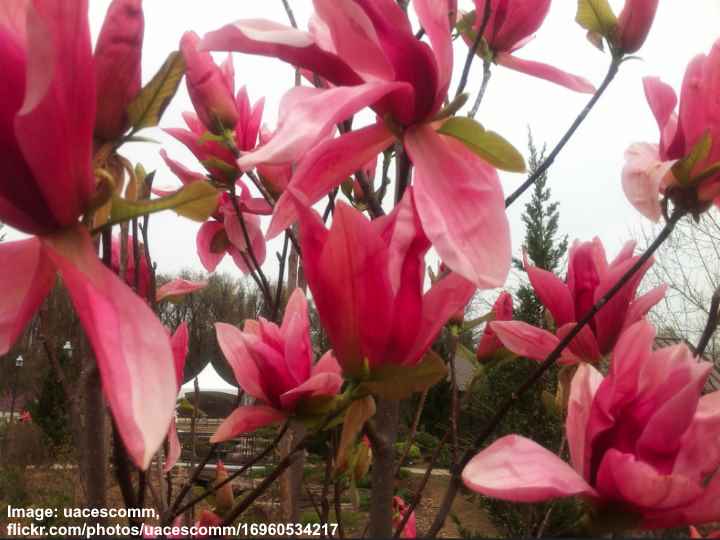
Magnolia ‘Daybreak’ flowers
Magnolia ‘Daybreak’ is a beautiful flowering tree known for its large, fragrant rose-pink blooms. The eight-petalled flowers measure 10” (25 cm) across. They contrast nicely with the medium green attractive foliage. This low-maintenance specimen magnolia grows up to 40 ft. (12 m) tall in full or partial sun.
The beautiful flowers of the ‘Daybreak’ magnolia cultivar emit a fragrant citrus scent. The flowers bloom in mid to late spring, meaning they usually avoid late frost damage that affects some early-blooming magnolias. The magnolia ‘Daybreak’ is tolerant of drought, making it ideal for urban landscapes.
- Bloom Time: Mid to late spring
- Plant Size: 30 – 40 ft. (9 – 12 m) tall and 13 to 15 ft. (4 – 4.5 m) wide
- USDA Plant Zone: 5 – 9
- Light: Full sun to partial shade
Magnolia ‘Elizabeth’
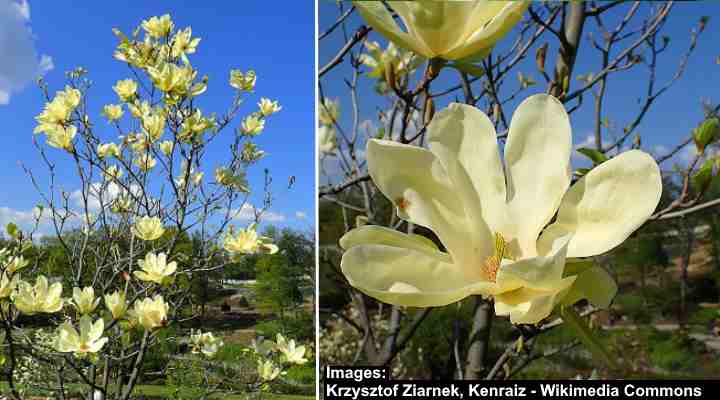
Magnolia ‘Elizabeth’
Magnolia ‘Elizabeth’ is one of the most beautiful yellow-flowering magnolias. The stunning cup-shaped primrose yellow blooms appear in early spring on bare branches. The oval leaves emerge bronze and are green throughout the season before turning golden yellow in the fall. The magnolia ‘Elizabeth’ hybrid cultivar grows up to 30 ft. (9 m) tall.
Identifying features of the award-winning ‘Elizabeth’ magnolia multi-stemmed shrub-like trees are their tulip-like yellow flowers 8” (20 cm) across, dark green oval leaves, furry seed pods, and smooth gray bark. It also has a conical habit that looks stunning covered in yellow blooms throughout spring.
- Bloom Time: Early to mid-spring for four weeks
- Plant Size: 20 – 30 ft. (6 – 9 m) tall and 12 to 20 ft. (3.6 – 6 m) wide
- USDA Plant Zone: 5 – 9
- Light: Full sun to partial shade
Star Magnolia ‘Jane Platt’ (Magnolia stellata ‘Jane Platt’)
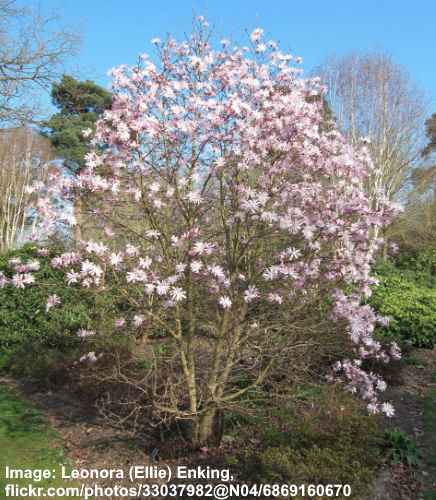
Star Magnolia ‘Jane Platt’ (Magnolia stellata ‘Jane Platt’)
The star magnolia ‘Jane Platt’ is one of the most stunning pink-flowering magnolia shrubs. The beautiful pink flowers feature up to 32 linear petals, forming double blooms on bare branches. The pretty blooms appear in early spring and persist for several weeks. The ‘Jane Platt’ magnolia grows up to 15 ft. (4.5 m) tall.
Ideal for small gardens, the star magnolia ‘Jane Platt’ star magnolia adds dramatic floral displays to landscapes. The pink flowers with a hint of white have a sweet fragrance, enhancing the magnolia’s appeal. It’s a stunning ornamental addition to any garden or landscape, adding beauty and fragrance to the early spring season.
- Bloom Time: Early or mid-spring
- Plant Size: 10 – 15 ft. (3 – 4.5 m) tall and 8 to 12 ft. (2.4 – 3.6) wide
- USDA Plant Zone: 4 – 8
- Light: Full sun to partial shade
Find out how to care for magnolia trees and shrubs.
Magnolia Tree Care
Magnolia trees thrive in well-drained soil, a crucial factor for their healthy growth and development. They are remarkably adaptable to a variety of soil types, including loamy, clay, and sandy soils. However, they prefer slightly acidic to neutral pH levels in the soil. The loamy soil, with its balanced mixture of sand, silt, and clay, is particularly beneficial as it provides the right combination of drainage and nutrient retention.
Magnolias can tolerate clay and sandy soils as well, but these may require amendments to improve fertility and water-holding capacity. Proper drainage is essential to prevent root rot and other water-related issues in magnolia trees.
Mulching: Apply a layer of organic mulch, such as wood chips or shredded bark, around the base of the magnolia tree. This layer, ideally 2 to 4 inches thick, helps retain soil moisture, regulates soil temperature, and reduces weed growth. It’s important to keep the mulch a few inches away from the trunk to prevent moisture buildup, which could lead to fungal diseases.
Watering: Magnolias require consistent moisture, especially during their first few years after planting and during dry spells. It’s crucial to water deeply and slowly, allowing moisture to reach the deeper roots. Avoid over-watering, as it can lead to root rot. The frequency of watering will depend on the soil type and weather conditions. In general, deep watering once a week during dry periods is beneficial.
Fertilizing: While magnolias aren’t heavy feeders, they can benefit from light fertilization. Use a balanced, slow-release fertilizer formulated for trees and shrubs, ideally in the spring before the growth season begins. Over-fertilizing can harm the tree, so it’s essential to follow the recommended application rates. Additionally, soil testing can be helpful to determine the specific nutrient needs of your magnolia.
Related Articles:
- The Most Beautiful Flowering Trees
- The Best Small Landscaping Trees
- Small or Dwarf Trees For Landscaping
